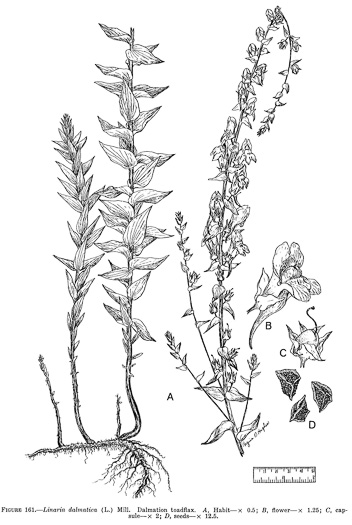Spermatophytes (seed plants): Angiosperms (flowering plants): Eudicots: Core Eudicots: Asterids: Lamiids: Lamiales
WEAKLEY'S FLORA OF THE SOUTHEASTERN US (4/24/22):
Linaria dalmatica ssp. dalmatica
FAMILY
Plantaginaceae
Go to FSUS key
Dig deeper at SERNEC, a consortium of southeastern herbaria.
Check out EDDMapS.org to see where this has been reported.
SYNONYMOUS WITH
PLANTS NATIONAL DATABASE:
Linaria dalmatica ssp. dalmatica
FAMILY
Scrophulariaceae
SYNONYMOUS WITH Floristic Synthesis of North America. BONAP (Kartesz, 2021)
Linaria dalmatica ssp. dalmatica
SYNONYMOUS WITH Flora of North America
Linaria dalmatica ssp. dalmatica
SYNONYMOUS WITH Vascular flora of Illinois (Mohlenbrock, 2014)
Linaria genistifolia ssp. dalmatica
COMMON NAME:
Dalmation Toadflax
To see larger pictures, click or hover over the thumbnails.
WEAKLEY'S FLORA OF THE SOUTHEASTERN US (4/24/22):
Linaria dalmatica ssp. dalmatica
FAMILY
Plantaginaceae
SYNONYMOUS WITH
PLANTS NATIONAL DATABASE:
Linaria dalmatica ssp. dalmatica
FAMILY
Scrophulariaceae
SYNONYMOUS WITH
Floristic Synthesis of North America. BONAP (Kartesz, 2021)
Linaria dalmatica ssp. dalmatica
SYNONYMOUS WITH
Flora of North America
Linaria dalmatica ssp. dalmatica
SYNONYMOUS WITH
Vascular flora of Illinois (Mohlenbrock, 2014)
Linaria genistifolia ssp. dalmatica
If a search such as "Carex leptalea var. leptalea" doesn't deliver the results you want, try "Carex leptalea".
Or, to minimize chances of a misspelling, try just "Carex le".
Less is more: If "pencil flower" doesn't deliver the results you want, try "pencil".


